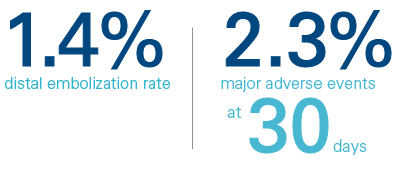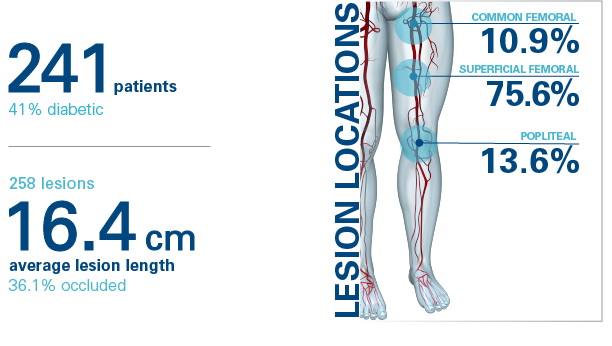Jetstream™
Atherectomy System
| 19.5% | 4 is dense circumferential calcification along the segment length |
| 28.2% | 3 is aggregate calcification representing >50% of the segment length |
| 24.1% | 2 is aggregate calcification representing <50% of the segment length |
| 16.2% | 1 is one individual segment of vessel calcification representing <25% of the length of the entire segment |
| 10.0% | 0 is no visible calcification |
Efficacy and Outcomes

* Patency based on a DUS PSVR ≤2.5; Binary Restenosis was reported as 22.8%. The JET Registry had limited DUS follow-up at 12 months (57/241 patients)
Patient Safety

Procedural Details
Catheter Sizes
• 47.2% used 2.1/3.0 mm
• 49.4% used 2.4/3.4 mm
Number of Passes (average*)
• 2.0 blades down
• 1.8 blades up
Embolic Protection
• 22.4% of cases
Jetstream Runtime (average*)
• 4.7 minutes
Subgroup Results

Summary
JET Registry data demonstrated:
- The JET Registry saw a 77.2% patency†† rate in patients with real-world, long femoropopliteal lesions (16.4 cm). No DCBs were used in this study
- There was a high freedom from TLR rate of 81.7% at 12 months
- There was a low distal embolization rate, 1.4% or 3 events
- Calcium was present in most of the lesions and grade 3 and 4 calcium was present in 47.7% of lesions
- The Jetstream Atherectomy System had a high procedural success rate, 98.3% of patients had ≤30% residual diameter stenosis post-procedure
†† Patency based on a DUS PSVR ≤2.5; Binary Restenosis was reported as 22.8%.















